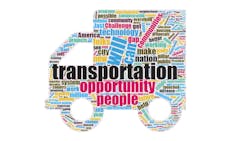Foxx outlines refocused transportation aims, autonomous vehicle support
A day after the final State of the Union address by President Obama and the day before he revealed a federal plan to accelerate the adoption of autonomous vehicles, Transportation Secretary Anthony Foxx outlined the administration’s broad plan to shift the focus of infrastructure projects away from “throughput” and instead to those that connect communities rather than divide them. The speech, however, offered few policy specifics and only touched briefly on freight issues.
The purpose, Foxx explained Wednesday at the Transportation Research Board’s annual gathering, is to use transportation as a means of addressing the “widening gap” between the wealthy and working class—not to make the gap worse.
“We should talk beyond taking people from their doorstep of opportunity. We should begin to talk about bringing opportunity to folks’ doorstep,” Foxx said. “But, to do that, all of us must embrace our role in closing the opportunity gap.”
Recalling how the neighborhood where he grew up had been isolated by two nearby freeway projects, Foxx specifically encouraged the gathering of transportation professionals and officials to consider how well a project “increases connectivity for all residents” and to look for solutions that “connect Point A to Point B, without forgetting the points and people in between.”
Foxx also noted that the he had created a new post at DOT: a Chief Opportunities Officer “to ensure that opportunity and inclusion is part of everything we do.”
Foxx opened with a brief of discussion of the new highway bill, the FAST Act, saying that “it is wonderful to start the year with a five-year surface transportation bill.”
Among the Obama administration’s policy proposals that made the five-year funding package, the new dedicated freight programs topped Foxx’s list. Asked later about specifics, Foxx said the administration is “very excited” to work with Congress on developing a strategic freight planning process.
“We’ve got a freight system that is multi-modal, that has very distinct bottlenecks and gaps in it,” Foxx said. “And frankly, some of our decision-making processes—the fact that we have basically 52 distinct freight systems—make it difficult, in a more fluid way, how the system all works together.”
A $1 billion allotment in the first year allows planners “to think holistically” about projects that serve the national system to move freight efficiently—“and our current system doesn’t encourage that as much.”
Autonomous vehicle technology likewise “introduces a whole new range of opportunities,” Foxx explained, and he immediately cited developments already underway in commercial vehicles.
“The possibility that we could have safe platooning of trucks on the road is a pretty remarkable opportunity for us to optimize our system,” Foxx said, and emphasized the federal role in encouraging innovation while also not compromising on safety. “We have to anticipate that the pace of change is going to be faster in the 21st century than it was in the 20th, and our regulatory processes have to able to keep up.”
His remarks turned out to be a preview of the Thursday announcement at the North American International Auto Show in Detroit, where he was joined by leaders in technology, executives of traditional auto manufacturers, and newcomers to the industry.
Along with the 10-year, nearly $4 billion federal investment, DOT will be removing potential roadblocks to the integration of “innovative, transformational” automotive technology that can significantly improve safety, mobility, and sustainability, Foxx explained.
“We are on the cusp of a new era in automotive technology with enormous potential to save lives, reduce greenhouse gas emissions, and transform mobility for the American people,” he said. “Today’s actions and those we will pursue in the coming months will provide the foundation and the path forward for manufacturers, state officials, and consumers to use new technologies and achieve their full safety potential.”
Foxx also unveiled policy guidance that updates the National Highway Traffic Safety Administration’s (NHTSA) 2013 preliminary policy statement on autonomous vehicles. The new guidance reflects the reality that the widespread deployment of fully autonomous vehicles is now feasible, according to DOT.
About the Author
Kevin Jones 1
Editor
Kevin has served as editor-in-chief of Trailer/Body Builders magazine since 2017—just the third editor in the magazine’s 60 years. He is also editorial director for Endeavor Business Media’s Commercial Vehicle group, which includes FleetOwner, Bulk Transporter, Refrigerated Transporter, American Trucker, and Fleet Maintenance magazines and websites.

